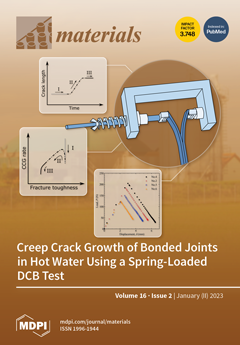Hydrazine borane (HB) is a chemical hydrogen storage material with high gravimetric hydrogen density of 15.4 wt%, containing both protic and hydridic hydrogen. However, its limitation is the formation of unfavorable gaseous by-products, such as hydrazine (N
2H
4) and ammonia
[...] Read more.
Hydrazine borane (HB) is a chemical hydrogen storage material with high gravimetric hydrogen density of 15.4 wt%, containing both protic and hydridic hydrogen. However, its limitation is the formation of unfavorable gaseous by-products, such as hydrazine (N
2H
4) and ammonia (NH
3), which are poisons to fuel cell catalyst, upon pyrolysis. Previous studies proved that confinement of ammonia borane (AB) greatly improved the dehydrogenation kinetics and thermodynamics. They function by reducing the particle size of AB and establishing bonds between silica functional groups and AB molecules. In current study, we employed the same strategy using MCM-41 and silica aerogel to investigate the effect of nanosizing towards the hydrogen storage properties of HB. Different loading of HB to the porous supports were investigated and optimized. The optimized loading of HB in MCM-41 and silica aerogel was 1:1 and 0.25:1, respectively. Both confined samples demonstrated great suppression of melting induced sample foaming. However, by-products formation was enhanced over dehydrogenation in an open system decomposition owing to the presence of extensive Si-O···BH
3(HB) coordination that further promote the B-N bond cleavage to release N
2H
4. The Si-OH···N(N
2H
4) hydrogen bonding may further promote N-N bond cleavage in the resulting N
2H
4, facilitating the formation of NH
3. As temperature increases, the remaining N-N-B oligomeric chains in the porous silica, which are lacking the long-range structure may further undergo intramolecular B-N or N-N cleavage to release substantial amount of N
2H
4 or NH
3. Besides open system decomposition, we also reported a closed system decomposition where complete utilization of the N-H from the released N
2H
4 and NH
3 in the secondary reaction can be achieved, releasing mainly hydrogen upon being heated up to high temperatures. Nanosizing of HB particles via PMMA encapsulation was also attempted. Despite the ester functional group that may favor multiple coordination with HB molecules, these interactions did not impart significant change towards the decomposition of HB selectively towards dehydrogenation.
Full article






